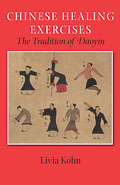start > Klassieke teksten > Late Han tot Tang > tekst
導引經 Daoyin jing
Engelse titel: Scripture on Healing Exercises
voluit: 太清導引養生經 Taiqing daoyin yangsheng jing - Great Clarity Scripture on Healing Exercises and Nourishing Life
Despeux; "Treatise of Great Purity on Gymnastics and Nurturing Vitality.'
This work is listed in the Bishu sheng xubiandao siku queshu mu (1145) under the title of Daoyin yangsheng jing, in one juan. The text is later than I427 Taiqing Daolin shesheng lun, to which it refers, and 824 Songshan Taiwu xiansheng qijing, which it cites. It probably dates in its present form to a period after the mid-eighth century. However, the Zhubing yuanhou lun (dated 610) and 836 Shenxian shiqi jingui miaolu already cite much the same material from traditional sources. On the basis of these citations, the majority of the exercises described here can be dated to the late sixth century. A relationship between the present text and the lost Yangsheng yaoji (fourth century; see Barrett, ''Transmission'') can only be surmised.
(..)
The work consists of a collection of gymnastics and breathing techniques, including those of Daolin (i.e., Zhi Dun, 314-366), representing the schools of various immortals of antiquity (Chisong zi, Ning Feng zi, Pengzul, Wangzi Qiao. Several of the latters' biographies in 294 Liexian zhuan are cited. The breathing techniques and animal-like movements placed under the patronage of Ning Feng zi continue an ancient tradition.
Remnants of this tradition dating from the Han period (206 B.C.-A .D. 220) have been unearthed in recent decades by archaeologists: the Gymnastics Chart (Daoyin tu) in Mawangdui, depicting movements and exercises; and a set of commentaries on these illustrations, inscribed on bamboo slips discovered separately in Jiangling, Hunan. (Despeux in Schipper 2004 The Taoist Canon vol1 p 95-96)
Livia Kohn 2008:
By the early middle ages, the practice of healing exercises has ex- panded widely and taken on various new forms and dimensions. Far from being merely a series of exercises that bend and stretch the body to relieve ailments and release tensions, it has become part of the official culture of moderation, the pre- ferred method of hermits to eliminate hunger and thirst and defend themselves against demons, and among Daoist practitioners—in combination with various devotional activities—a preparatory technique for the attainment of otherworldly visions and the ascension into heaven.
What began as a medical routine to prevent aging and cure diseases, in the varied setting of fourth-century southern aristocracy, has thus grown into a complex and multi-layered phenomenon, its different parts at variance with one another yet already showing the potential for the integration and systematization that would soon come to the fore.
The first such systematization of healing exercises and routines ap- pears in the Daoyin jing, the only text in the Daoist canon that deals exclusively with physical practices. Its full title is Taiqing daoyin yangsheng jing (Great Clarity Scripture on Healing Exercises and Nourishing Life, DZ 818; see Despeux 1989).
(...)
The Daoyin jing stands out from previous medical practices and animal forms in that it presents exercise sequences associated with four major ancient immortals, all with first biographies in the Han-dynasty Liexian zhuan 列仙傳 (Immortals’ Biographies, DZ 294; trl. Kaltenmark 1953). Important legendary figures of the Daoist tradition, they are Pengzu 彭祖, who allegedly ate only cinnamon and lived for hundreds of years through the Xia and Shang dynasties; Chisongzi 赤松子 or Master Redpine, the Lord of Rain under the mythical Divine Farmer (Shennong 神農), best known for his magical powers of riding the wind; Ningfengzi 寧封子 or Master Ning (the Lord of Fire under the Yellow Emperor), who was immune to heat and burning; and Wangzi Qiao 王子蹻 who could travel through the universe at will. As different methods and sequences are ascribed to them, it is quite possible that these four ancient masters were representatives of different schools (Despeux 1989, 230).
Indeling tekst
Kohn 2012 Sourcebook p99 - 116.
Master Redpine (vers 1-12)
Master Ning (1-9)
The Frog Way of Guiding Qi (1-21)
The Turtle Way of Guiding Qi (1-11)
The Wild Goose Way of Guiding Qi
The Dragon Way of Guiding Qi (1-3)
Ways of Inhaling Lunar Essence (1-17)
Master Ning says
Pengzu’s Supine Practice for Nourishing Immortality (1-10)
Wangzi Qiao’s Eight Spirit Healing Exercises
To Cure All Sorts of Diseases by Holding the Breath
From Wangzi Qiao’s Exercise Chart
From Pengzu’s Exercise Chart
Formula for Cleansing Qi
Formula for Swallowing Qi (1-26, 1-18)
Master Redpine’s seated exercises (1-6)
Literatuur en vertalingen
Toelichting bij de literatuur
Een samenvatting is te vinden in Kohn 2008 Chinese healing exercises, hst 3 p 98-127
Een vertaling (bloemlezing?) in Kohn 2012 A Sourcebook in Longevity p 99-116
Hieronder kunt u een selectie maken van de verschillende publicatievormen en de taal. Ik beperk me tot vier taalgebieden (Nederlands, Engels, Frans en Duits). De meeste literatuur is overigens engelstalig. U kunt bij teksttype ook apart de vertalingen selecteren en U kunt desgewenst ook een specifieke auteur zoeken.
Boeken 1 tot 1 van de 1
Boeken 1 tot 1 van de 1

